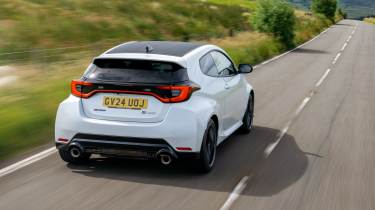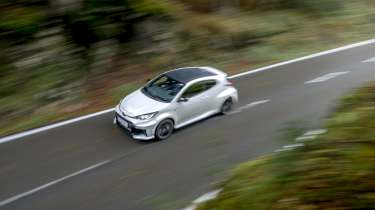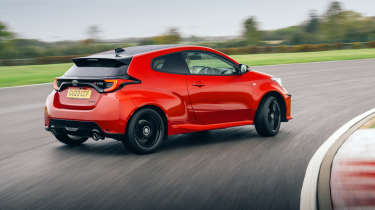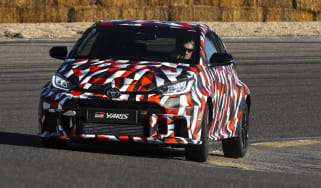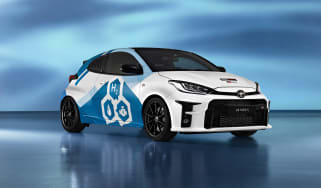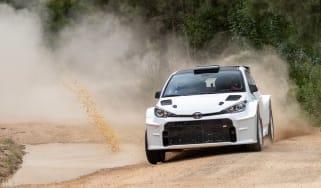Toyota GR Yaris 2025 review – the modern homologation special gets even better
Toyota’s GR Yaris was always brilliant but has received a number of key and welcome updates. It’s even better but also, a lot more expensive.
We can’t think of a modern performance car that has generated more hype surrounding its arrival – and has lived up to it – than the Toyota GR Yaris. The original Toyota GR Yaris defied critics and shook this weight off its shoulders with a truly unique driving experience that’s as exciting as we all hoped it would be when we saw its stout little body for the first time in 2019. The updated car built upon the brilliance of the original – addressing criticisms yes, but also, unfortunately, with significantly reduced supply and a much higher price.
That’s a shame, because the instant success of the original was in part due to its many talents but moreso, the relative accessibility of those talents both in terms of price and availability. But the Gen 2 remains an authentic, motorsport-inspired product – a performance car not created solely on the basis of a marketing plan, or to lower a meaningless lap record around a given circuit, but to serve as the ideal base from which to mount a top-flight motorsport campaign. The Toyota GR Yaris is a true homologation special in the most literal sense, even if the car it was created to homologate never actually competed.
This approach has given us some of the most revered evo cars of all time, from the Ford Sierra RS Cosworth to the Porsche 993 GT2, and so many more. And it’s one that (thankfully) resonates with buyers, with demand far outstripping supply across Japan and Europe at its launch, creating lengthy waiting lists and values that rose over and above its original £30,020 base price, a figure that was almost £15,000 less than the updated car of today.
Despite having been on the market for four years, this excellent recipe helped the pre-update GR Yaris achieve a remarkable second place finish in issue 318's 18-car hot hatch mega test. While some of the contenders were undoubtedly more warm than hot, it went head-to-head with much more powerful (and expensive) machinery from the likes of Mercedes-AMG and BMW, but only the Honda Civic Type R came out ahead.
More reviews
Long term tests
Reviews
The updated car then arrived, with a revised design and a power boost to 276bhp among myriad detail changes and yes, a jump up in basic price, to £44,250. But even with what is quite a large elephant in the room to consider, the latest GR Yaris continues to thrill and excite in all the familiar ways.
Although it looks very similar to the original GR Yaris on the outside, there have been a great many detail changes beneath the surface to make the Gen 2 car a thoroughly updated machine. Some of the most important changes include a much improved driving position, stiffened bodyshell, the option of a new eight-speed auto transmission (and an improved shift for the standard six-speed manual), more power and torque, enhanced cooling including a water-spray switch for the intercooler and a brand-new dashboard fascia.
Toyota GR Yaris: in detail
- Engine, gearbox and technical highlights > The bespoke 1.6-litre triple is a little gem of an engine. Stronger and more powerful now and still brilliant.
- Performance and 0-60 time > On-paper figures don’t relay this car’s immense cross-country pace
- Ride and handling > So unique, so fascinating, with added focus (and a bit more harshness) in Gen 2 form
- MPG and running costs > Short gearing, a big turbo and a tiny fuel tank will make trips to the bowsers a common game
- Interior and tech > Not the most spacious little car but nicely thought out, in both pre- and post-update guises
- Design > It’s butch, hardy, aggressive and desirable, all despite having a Yaris badge attached to its rump. The updated look doesn’t change this
evo hyperhatch test, issue 332
In issue 332 of evo, we pitted the Yaris against two of the most advanced four-wheel drive hot hatches available - the Audi RS3 and Mercedes-AMG A45 S. Here's how it fared:
'The Yaris behaves in the most conventional way, but it’s able to do quite extraordinary things. Few cars at any price are as approachable or immediately exploitable, and of the three, it's the one that consistently gets the best out of the conditions you throw at it. It makes the RS3 feel big and a bit loose, and the Mercedes detached and synthetic.
It boils down to whether the Yaris's sense of connection, control and sky high limits are enough to keep you engaged, and whether you can pass up on the magic moments the less finely honed RS3 can deliver. It’s not an easy call, and there are times when you wish the Yaris would loosen its reins and bite you for taking such absurd liberties with it. But it’s objectively the best road car here, and no other hot hatch feels so tailor made for the rough and tumble of Welsh roads.'
Yousuf Ashraf, evo 332
Prices, specs and rivals
When it first arrived, the original Toyota GR Yaris was available in three flavours: base (£30,020), Convenience Pack (£32,200) and Circuit Pack (£33,520). Mechanically, the first two are identical, with the Convenience Pack car building on the interior specification with integrated satnav, a larger JBL stereo, head-up display and parking sensors.
Circuit Pack cars didn’t share those interior upgrades, instead bringing those key changes under the skin that made best use of the GR’s sweet little chassis. These include larger brakes, forged Enkei wheels with Michelin PS 4 rubber (Dunlops are standard), a stiffer suspension tune and a locking differential on both axles.
With the new car, the auto model costs £45,750 to the manual’s £44,250. Two limited special editions, named after Toyota WRC drivers Sébastien Ogier and Kalle Rovanperä are manual and priced at £60,000, with the Gravel and Track AWD modes replaced with special settings personally tuned by the respective drivers.
GR company insiders freely admit that they never expected the car to be the smash hit it has become. Initially, 25,000 cars were planned to be built to meet rally homologation requirements. So far more than 40,000 GR Yarises have been sold worldwide since launch in 2020, with around half of those sales in Europe. Reportedly, around 10,000 customers were on the waiting list for the old car in the UK alone. So we can expect the Gen 2 car to be thoroughly oversubscribed.
Direct rivals to the GR Yaris were always varied and few, but especially so now, as the small hot hatch arena is all but barren. Even when it was new, no hot hatchback matched the GR in size, performance and price point.
The king of the supermini hot hatchback was the Ford Fiesta ST, which in its sole ST-3 guise was still cheaper (£27,320) but down on power and front-wheel drive only. The £25,250 Hyundai i20 N was also a key rival from below before it too received the axe. It’s brilliantly involving and feels more substantial on account of its extra kit and N’s typical driver-mode mellay.
Still kicking and at the other end of the size spectrum is the Honda Civic Type R, which like the new GR Yaris, is a pricey device, at £50,050. Comparable then to the Toyota on the basis of price and its unrelenting focus and stunning capability. The aforementioned Audi RS3 and AMG A45 S are even more expensive at over £60k, and while they offer more performance and configurability than the Yaris, they feel less bespoke and confidence inspiring. With that said, the RS3's wonderful five-pot engine and highly adjustable four-wheel drive system make for an intoxicating mix that runs the Toyota close on the road, and beats it on track.


